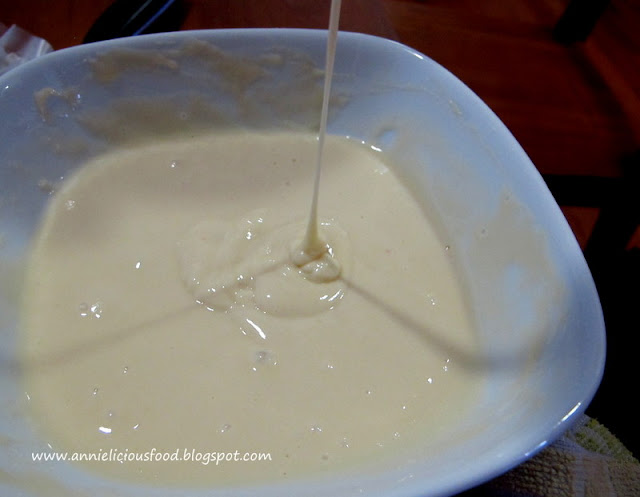My mother told me that Cantonese usually prepare fish porridge, stir fried rice vermicelli and fried sticky rice cake in celebrating of 7th day of Chinese New Year. Although I don't really know the significance behind, but this is what my family usually do when I was young.
This is not just for Chinese New Year. It makes great party finger food too. I always keep left-over sticky rice cake in my fridge every year :)
Ingredient (Makes about 10 pieces)
(Recipe Source : My mother - Mdm. Chai)
- about 250g Sticky Rice Cake 年糕 (must use hardened sticky rice cake)
- about 300g Taro 芋头 (I use Thai Taro)
- about 300g Orange Sweet Potatoes 橙色番薯
The Batter
- 4 tbsp Plain Flour 面粉
- 1 tbsp Cake Flour 蛋糕粉
- 1 tbsp Rice Flour 粘米粉
- 1/2 tbsp Tapioca Flour 薯粉
- 1 Egg 鸡蛋
- 40ml to 50ml Water 水 (or more)
- 1/2 tsp Sugar 糖
- a pinch of Salt 盐
- Heat up some oil for deep frying using medium low heat. Once the oil is hot enough, reduce to low heat.
- Sandwich the sticky rice cake with taro at one side, and sweet potato at another side.
- With the help of chopstick and spoon, coat the sandwich with batter, try to maintain it's shape, put the coated sandwich into the oil and fry it.
- Under low fire, slowly fry the sandwiched sticky rice cake. This is to ensure the taro and sweet potatoes are equally cooked before the batter turned golden. If your fire is too high, the batter will turn brown very fast, and you get raw taro and sweet potatoes. This is very important. Do remember. Heat control is very very important. If you are not confident enough, use a skewer to test poke on the sandwiched sticky rice cake to see if the entire piece of sandwiched sticky rice cake is cooked. When you tested one, you should be able to gauge the frying time for the next batch.
- Once it turned golden brown, dish up, drain on paper towel and let it cool down abit before serving.
Tips : If you are so worried that the taro and sweet potatoes will not get cooked evenly, you can steam the taro and sweet potato for awhile (till half-cooked) before you sandwich the sticky rice cake for frying. Another alternative, slice your taro and sweet potato into thinner piece. Easier to get cooked :)
Chef Mdm.Chai at work. Hahaha...
See? This is the right consistency of the batter. It must be lump free and smooth. Not that thick and not that runny. If it is too runny, batter won't stick to the sandwich. If batter too thick, you will end up having thick crust.
Look at my sandwiched sticky rice cake again. Nice? I spent quite abit of time to do all the cutting. And by the way, the hardened sticky rice cake will be much easier to cut than when it is soft and sticky. If your sticky rice cake is soft, do consider to put them into the fridge overnight before cutting. It would be easier.
Ahhh.. I love seeing the sandwich. Orange, brown, pale purple. Nice! Wendy commented that the taro at the bottom layer looked raw. But it is not. It's soft! Hahaha. Don't get cheated. The reason why I could halved it nicely is because I let it down before I cut them into half. I want it looks nice on photos lah. Cooled down sandwich gives better cutting result. If I cut it when it is hot, then you will see the softness of the taro. But the sticky rice will just ooze all over.
My niece is standing beside me when I doing the deep-frying work. She's pinching the hot slices right off the hot oil and eating them at the risk of burning their mouth! Duh!
But seriously, this is really very hard to resist :D




























